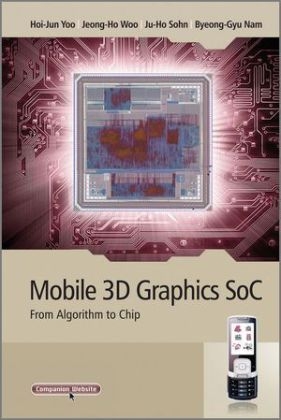
Mobile 3D Graphics SoC
Wiley-IEEE Press (Verlag)
978-0-470-82377-4 (ISBN)
- Lieferbar (Termin unbekannt)
- Versandkostenfrei innerhalb Deutschlands
- Auch auf Rechnung
- Verfügbarkeit in der Filiale vor Ort prüfen
- Artikel merken
The first book to explain the principals behind mobile 3D hardware implementation, helping readers understand advanced algorithms, produce low-cost, low-power SoCs, or become familiar with embedded systems As mobile broadcasting and entertainment applications evolve, there is increasing interest in 3D graphics within the field of mobile electronics, particularly for handheld devices. In Mobile 3D Graphics SoC, Yoo provides a comprehensive understanding of the algorithms of mobile 3D graphics and their real chip implementation methods. 3D graphics SoC (System on a Chip) architecture and its interaction with embedded system software are explained with numerous examples. Yoo divides the book into three sections: general methodology of low power SoC, design of low power 3D graphics SoC, and silicon implementation of 3D graphics SoCs and their application to mobile electronics. Full examples are presented at various levels such as system level design and circuit level optimization along with design technology. Yoo incorporates many real chip examples, including many commercial 3D graphics chips, and provides cross-comparisons of various architectures and their performance. Furthermore, while advanced 3D graphics techniques are well understood and supported by industry standards, this is less true in the emerging mobile applications and games market. This book redresses this imbalance, providing an in-depth look at the new OpenGL ES (The Standard for Embedded Accelerated 3D Graphics), and shows what these new embedded systems graphics libraries can provide for 3D graphics and games developers.
Hoi Jun Yoo is a Professor of Electrical Engineering at the Korea Advanced Institute of Science and Technology (KAIST) and currently serves as Project Manager for the Korea Ministry of Information and Communication's IT SoC and Post-PC programs. Yoo's industry experience includes time with Bell Communications Research in Red Bank, NJ, where he invented the two-dimensional phase-locked VCSEL array, the front-surface-emitting laser, and the high-speed lateral HBT, as well as an appointment as Manager of a DRAM design group at Hyundai Electronics. He has written popular Korean books on DRAM design and high performance DRAM, and in 1994 received the Electronic Industrial Association of Korea Award for his contribution to DRAM technology, along with the Korea Semiconductor Industry Association Award in 2002. Yoo is the founder the System Integration and IP Authoring Research Center (SIPAC), a national-level center funded by the Korean government. Yoo holds a B.S. in Electronic Engineering from Seoul National University and an M.S. and Ph.D degrees in Electrical Engineering from KAIST. Jeong-Ho Woo is a PhD candidate at KAIST. Ju-Ho Sohn works at LG Electronics, and Byung-Gyu Nam works for Samsung.
Preface. 1 Introduction.
1.1 Mobile 3D Graphics.
1.2 Mobile Devices and Design Challenges.
1.2.1 Mobile Computing Power.
1.2.2 Mobile Display Devices.
1.2.3 Design Challenges.
1.3 Introduction to SoC Design.
1.4 About this Book.
2 Application Platform.
2.1 SoC Design Paradigms.
2.1.1 Platform and Set-based Design.
2.1.2 Modeling: Memory and Operations.
2.2 System Architecture.
2.2.1 Reference Machine and API.
2.2.2 Communication Architecture Design.
2.2.3 System Analysis.
2.3 Low-power SoC Design.
2.3.1 CMOS Circuit-level Low-power Design.
2.3.2 Architecture-level Low-power Design.
2.3.3 System-level Low-power Design.
2.4 Network-on-Chip based SoC.
2.4.1 Network-on-Chip Basics.
2.4.2 NoC Design Considerations.
2.4.3 Case Studies of Chip Implementation.
3 Introduction to 3D Graphics.
3.1 The 3D Graphics Pipeline.
3.1.1 The Application Stage.
3.1.2 The Geometry Stage.
3.1.3 The Rendering Stage.
3.2 Programmable 3D Graphics.
3.2.1 Programmable Graphics Pipeline.
3.2.2 Shader Models.
4 Mobile 3D Graphics.
4.1 Principles of Mobile 3D Graphics.
4.1.1 Application Challenges.
4.1.2 Design Principles.
4.2 Mobile 3D Graphics APIs.
4.2.1 KAIST MobileGL.
4.2.2 Khronos OpenGL-ES.
4.2.3 Microsoft’s Direct3D-Mobile.
4.3 Summary and Future Directions.
5 Mobile 3D Graphics SoC.
5.1 Low-power Rendering Processor.
5.1.1 Early Depth Test.
5.1.2 Logarithmic Datapaths.
5.1.3 Low-power Texture Unit.
5.1.4 Tile-based Rendering.
5.1.5 Texture Compression.
5.1.6 Texture Filtering and Anti-aliasing.
5.2 Low-power Shader.
5.2.1 Vertex Cache.
5.2.2 Low-power Register File.
5.2.3 Mobile Unified Shader.
6 Real Chip Implementations.
6.1 KAIST RAMP Architecture.
6.1.1 RAMP-IV.
6.1.2 RAMP-V.
6.1.3 RAMP-VI.
6.1.4 RAMP-VII.
6.2 Industry Architecture.
6.2.1 nVidia Mobile GPU – SC10 and Tegra.
6.2.2 Sony PSP.
6.2.3 Imagination Technology MBX/SGX.
7 Low-power Rasterizer Design.
7.1 Target System Architecture.
7.2 Summary of Performance and Features.
7.3 Block Diagram of the Rasterizer.
7.4 Instruction Set Architecture (ISA).
7.5 Detailed Design with Register Transfer Level Code.
7.5.1 Rasterization Top Block.
7.5.2 Pipeline Architecture.
7.5.3 Main Controller Design.
7.5.4 Rasterization Core Unit.
8 The Future of Mobile 3D Graphics.
8.1 Game and Mapping Applications Involving Networking.
8.2 Moves Towards More User-centered Applications.
8.3 Final Remarks.
Appendix Verilog HDL Design.
A.1 Introduction to Verilog Design.
A.2 Design Level.
A.2.1 Behavior Level.
A.2.2 Register Transfer Level.
A.2.3 Gate Level.
A.3 Design Flow.
A.3.1 Specification.
A.3.2 High-level Design.
A.3.3 Low-level Design.
A.3.4 RTL Coding.
A.3.5 Simulation.
A.3.6 Synthesis.
A.3.7 Placement and Routing.
A.4 Verilog Syntax.
A.4.1 Modules.
A.4.2 Logic Values and Numbers.
A.4.3 Data Types.
A.4.4 Operators.
A.4.5 Assignment.
A.4.6 Ports and Connections.
A.4.7 Expressions.
A.4.8 Instantiation.
A.4.9 Miscellaneous.
A.5 Example of Four-bit Adder with Zero Detection.
A.6 Synthesis Scripts.
Glossaries.
Index.
| Erscheint lt. Verlag | 11.6.2010 |
|---|---|
| Reihe/Serie | IEEE Press |
| Sprache | englisch |
| Maße | 174 x 252 mm |
| Gewicht | 744 g |
| Einbandart | gebunden |
| Themenwelt | Informatik ► Grafik / Design ► Digitale Bildverarbeitung |
| Technik ► Elektrotechnik / Energietechnik | |
| ISBN-10 | 0-470-82377-1 / 0470823771 |
| ISBN-13 | 978-0-470-82377-4 / 9780470823774 |
| Zustand | Neuware |
| Haben Sie eine Frage zum Produkt? |
aus dem Bereich


